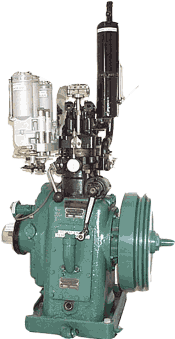
 |
Gasoline Octane Test Engine: Rescued from going to the scrap heap. This is a "Waukesha", CFR F-1 Research (ASTM D 2699) Variable Compression Single Cylinder Engine. Compression Adjustable 4:1 to 18:1 Cylinder Bore = 3.250" Stroke = 4.500" Displacement = 37.33 Cubic inches RPM = 600 Used at this plant from 1944 to 1990 |
|
|
|
My work involves running and maintaining these
interesting engines in a West |

A Little Octane Engine History:
The Cooperative Fuel Research ( CFR ) Committee which formed to respond to the need of refiners and engine builders to develop a means of measuring and defining gasoline combustion characteristics. In 1928 the committee had reached the decision that a standardized single cylinder test engine was needed as a first step in developing a gasoline knock-test method. In December 1928 the decision was made to proceed with a design, and the Fuel Research Engine was designed and built in 45 days to be ready for the January 1928 SAE meeting! This engine is still preserved at Waukesha Engine today. This engine gave the engine and fuel industries the first universally accepted standard test engine which could be produced in sufficient quantity to meet industry needs. There were other knock test engines in the running but each of these had drawbacks which prevented universal acceptance, so by the early 1930's most of these had gone out of use in favor of the new Waukesha CFR engine. This design has survived and flourished through two upgrades of the crankcase to the present time without any change in combustion chamber shape, compression arrangement, so that a rating made on the earliest engine will still match the octane made on today's engine nearly 70 years later. The means for quickly and accurately varying the compression ratio without affecting valve clearances or basic combustion chamber configuration was probably what caused this design to prevail over all other rivals. Moving the entire cylinder up and down with respect to the piston was far better than changing shims, moving a plug in the combustion chamber, or running with fixed compression. These engines were produced on a three-shifts-per-day basis during World War II, making principally the supercharged aviation gasoline test unit which helped in the development of 100 octane and eventually the 115/145 grade fuel which gave the allied air forces an edge over the axis nations which did not have such fuel at the time, thus contributing to the fall of the totalitarian powers. |
Most of this history was lifted from an article written
by Ivan Baxter, who was the CFR Engine Program Manager
|
|
Waukesha
manufactured the original Octane Engine design from
1930 to 1948 as the low-speed crankcase.
|
Site Links:
|
THE
CFR TRADING POST |
CFR, Around the World: |
||
| ENGINE PICS # 2 | OLD CFR INSTRUMENTS PAGE | Mirrored Octane Site: WWW.RUNYARD.ORG |
John's HOME PAGE |
INTERESTING LINKS and
OCTANE ENGINE SERVICES
 |
You can also reach John's CFR Engine Web Site at: www.johnrunyard.com or at The AD FREE, WWW.RUNYARD.ORG Comments: Drop me a line.
You are #
Updated: 02/16/2009
|